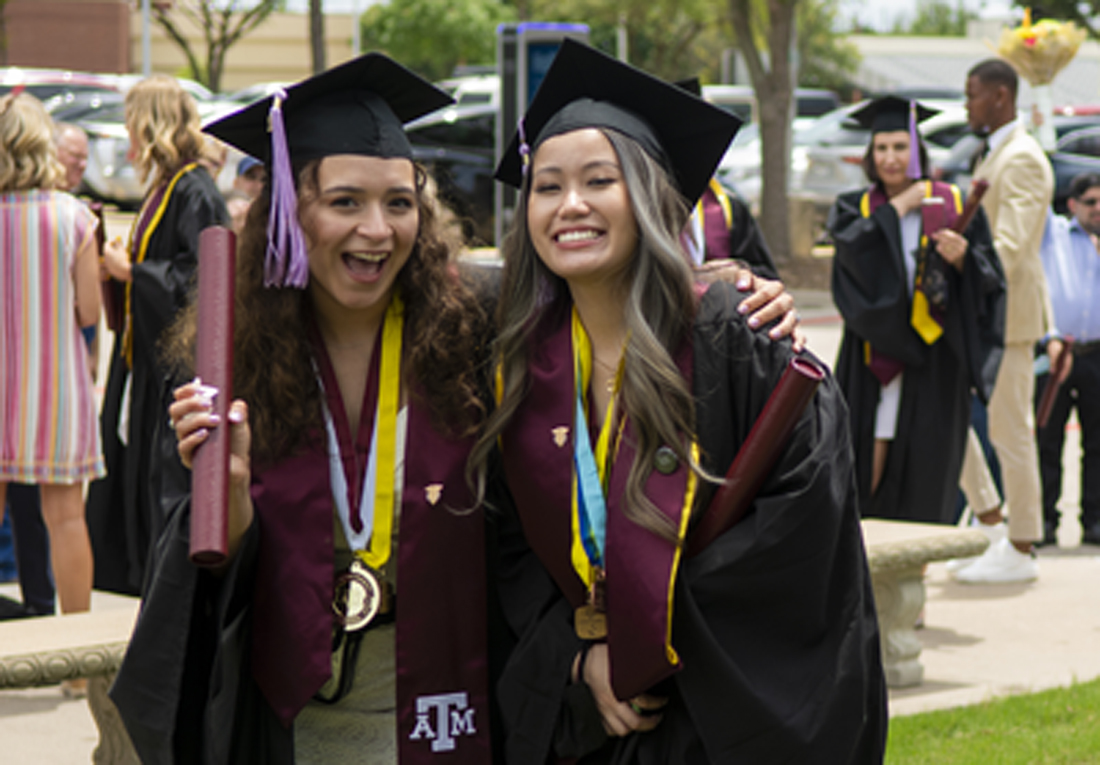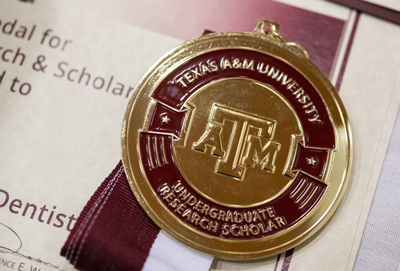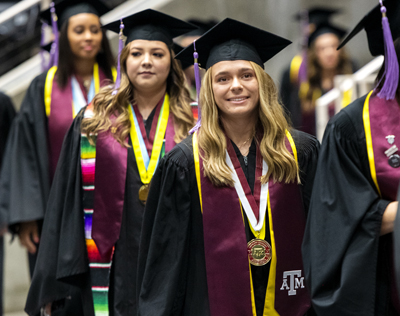Ribbons for research

For the first time in Caruth School of Dental Hygiene history, select students donned research medallions as part of their official graduation regalia.
Nineteen dental hygiene students received the medallions at Texas A&M College of Dentistry’s awards program a day before graduation. Those shiny gold circles with maroon and white ribbons mark their research accomplishments in a partnership between Caruth and the Undergraduate Research Scholars program, a LAUNCH initiative at Texas A&M University. Their transcripts also include a “research scholar” designation.
 “Our collaboration with the Undergraduate Research Scholars program, a signature high-impact initiative at TAMU, is one of our newest endeavors to provide a further enriching research experience for our students,” says Dr. Faizan Kabani, director of the undergraduate dental hygiene research program.
“Our collaboration with the Undergraduate Research Scholars program, a signature high-impact initiative at TAMU, is one of our newest endeavors to provide a further enriching research experience for our students,” says Dr. Faizan Kabani, director of the undergraduate dental hygiene research program.
The Class of 2020 dental hygiene research scholars were the first to complete the program, but a virtual graduation due to COVID-19 restrictions hampered any opportunity for students to sport their new medallions. Last year’s graduates were some of the first to have their thesis published in peer-reviewed journals, a feat the Class of 2021 hopes to repeat.
“Our students are making a tremendous impact in the field,” says Dr. Sarah Misemer, associate director of LAUNCH in College Station.
Several students admitted that research wasn’t originally on their professional checklist, although recent graduate Ashley Heim says she was intrigued as she watched her older sister go through the process when she attended dental hygiene school several years ago.
“I believe my interest in research grew even more when I entered the program,” she says, “and I was able to collaborate with two of my classmates on a topic that we felt passionate about and wanted to increase our knowledge on.”

In the Class of 2021’s second year as dental hygiene students, they signed up for a research class taught by Kabani. As the semester progressed, they became less intimidated as they increased their ability to make evidence-based decisions.
“Dr. Kabani’s passion for research really rubbed off on me,” says Keely Ehlers, 2021 class president. “I never imagined that I would feel confident enough to compete in not only one but several research competitions.”
Igniting a passion for research, evidence-based thinking and lifelong learning is the broader goal, Kabani says.
“As an educator and lifelong learner, I am convinced that research plays a valuable role in guiding our students to be better clinicians and people,” he says. “This is particularly true today as we all navigate through a time where information, including misinformation, is readily available at our fingertips.”
Students are required to produce a thesis to be published in the Undergraduate Research Scholars Capstone Collection in the Texas A&M OAKTrust Repository. They also share their research with poster presentations at the school’s Research Scholars Day, as well as at the state level. Award-winning entries then advance to the national level. In the past five years, several groups have placed at both state and nationals.
This year, two teams tied for first place and will present their research at the virtual American Dental Hygienists’ Association Annual Conference in June. Ehlers, Kali White and Allyson Howerton and Heim, Flor Eguia and Shermy Thomas make up the two Caruth teams that will compete.
During the process of readying their projects, dental hygiene students say, they realized how research knowledge could translate to their patients. By learning how to evaluate scientific articles, the students will be better equipped to understand advances in the field, information that can directly impact their everyday work procedures as dental hygienists.
According to Misemer with LAUNCH, undergraduate research has been shown to improve retention and learning. Through hands-on experiences, students can apply what they’ve learned in the classroom and research to the real world.
Students also develop skills—communication, time management, critical thinking, ethical practices, and collaboration—that will be beneficial in the workplace, she says.
“All of these elements reinforce Texas A&M University’s commitment to teaching students lifelong learning skills, reinforcing student success initiatives, and producing Aggies who are future leaders in our communities,” Misemer says.
And, of course, working in groups toward a shared goal reinforces student bonding, networking and a chance to study with mentors, she says.
Kabani adds that the experience provides a leg up if students decide to pursue graduate school or future research.
As they worked on their projects for two semesters, the time together definitely fostered camaraderie despite many exhausting days when they put in multiple hours beyond regular school work, Heim says.
“We all were very passionate about the research topic we wanted to further bring awareness about, and I think that is one of the reasons we clicked instantly from the beginning,” she says.
Teammate Thomas, who always enjoyed science fair projects in middle school and high school, shared Heim’s enthusiasm for their research journey.
“My research team and I truly have an unbreakable bond now as a result of working together for so many hours and spending even more time on Zoom calls together,” she says. “We all equally have a tremendous heart and passion toward our topic, and I am extremely proud of my team.”